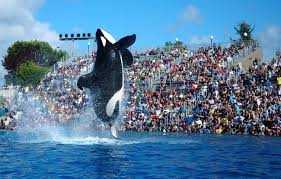
Imagine being forced to share an apartment with people you don’t know from different cultures for the rest of your life. You wouldn’t be allowed to leave whenever you want and food would be brought to you when you behaved well. Sounds pretty terrible, doesn’t it? Well, that’s exactly what the lives of orcas are like in SeaWorld and other ocean parks around the globe.
Ocean parks, especially the most well-known park, SeaWorld, have been controversial from the very beginning. However, the problems revolving around the parks have only gotten into the spotlight during the past few years, after a trainer was killed by an orca in 2010, and ‘Blackfish’, a documentary about killer whales kept in captivity, was released in 2013.
Tilikum, now a 33-year-old killer whale, is at the centre of the conversation as he killed three trainers during his 30 year career in ocean parks. Tilikum was first owned by Sealand of the Pacific in the 1980s until 1991, when a part-time trainer fell into a pool and was killed by Tilikum and two other orcas. Following the incident, Sealand closed its doors and sold the whales to SeaWorld, Orlando. Selling Tilikum, an orca with a history of aggression, to SeaWorld was a mistake. Both, Sealand and SeaWorld should have realised that the orcas should not be kept in captivity when the first death occurred.
This attack was not the only one by Tilikum. In 1999, Tilikum killed another human, Daniel Dukes, who was found naked and dead on Tilikum’s back. Dukes had a criminal background and it was almost too easy for SeaWorld to put the blame on the victim. The last person killed because of Tilikum’s stress and frustration is Dawn Brancheau, who died in 2010. In addition to these unfortunate deaths, there are multiple records of other attacks in ocean parks.
Orcas are incredibly friendly animals and this kind of aggressive behaviour towards humans is almost only encountered with the orcas kept in captivity. In fact, not a single killer whale has ever killed a human in the wild. The concrete tanks where the orcas are kept in SeaWorld are simply too small for the whales who can swim up to 160 kilometres per day in the wild. To reach that they would have to swim 1208 laps around the largest tank in the park, so it is no wonder that they have mental health problems in captivity.
The whales suffer from severe stress, anxiety and boredom that unravels in aggression, repetitive behaviour, floating and chewing of metal bars and pool corners. Leaked documents show that the orcas kept in captivity are given benzodiazepines, a psychoactive drug, in an attempt to keep their mental health stable. In addition to mental health issues, orcas held in captivity often have issues with their physical health too: collapsed dorsal fins, teeth problems due to the chewing and physical injuries resulting from the fights.
Orcas are extremely intelligent and highly social animals that live in close social groups and often stay with their mothers for life. Different groups of orcas can be compared to different nationalities as they live in totally different cultures and have languages of their own. In captivity, they are forced to live with individuals from foreign societies, which causes stress and fights among the whales. The orcas are simply not meant to live in small and acoustically dull concrete tanks with total strangers.
Lately, it has been increasingly difficult for SeaWorld to go on with the show. In 2014, the United States Court of Appeals ruled that SeaWorld trainers would be prohibited to enter the water with the whales, and just a few weeks ago the California Coastal Commission banned the breeding of captive orcas in the San Diego ocean park. Even though the Commission approved a new $100 million tank expansion, SeaWorld will have nothing to fill them up with, which will, according to PETA, ultimately end captivity for long-suffering orcas in California.
SeaWorld Entertainment Inc. published its second quarter earnings statement, which showed that the ocean park corporation had faced a massive 84 per cent decline in earnings compared to only a year ago. It looks like the attitudes have changed and people don’t want to pay to see animals suffering anymore, but SeaWorld is still refusing to change. SeaWorld could move its orcas to coastal sanctuaries where the animals could live a happier life in an environment that imitates the natural habitat of killer whales, but instead, Sea World is adamant in fighting the breeding ban.
Sonja Sjogren
Image Credit: Wikimedia Commons




Leave a Reply